
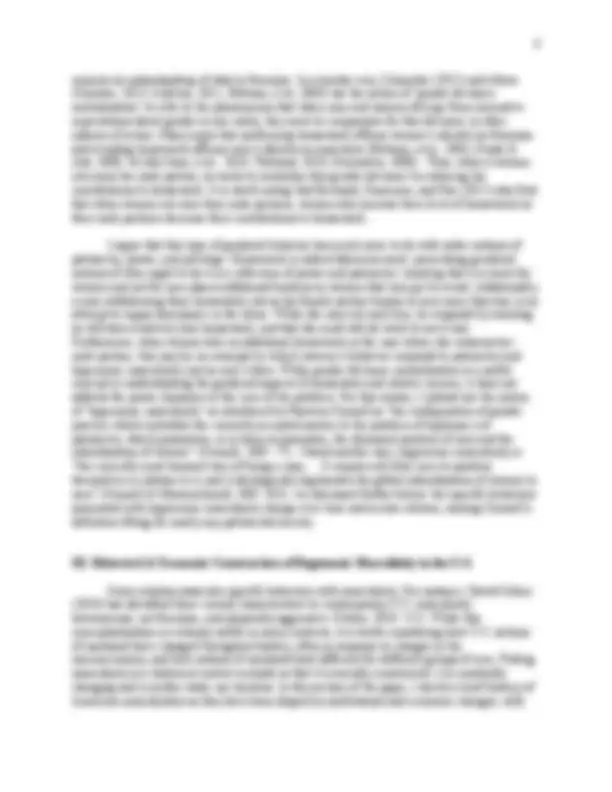
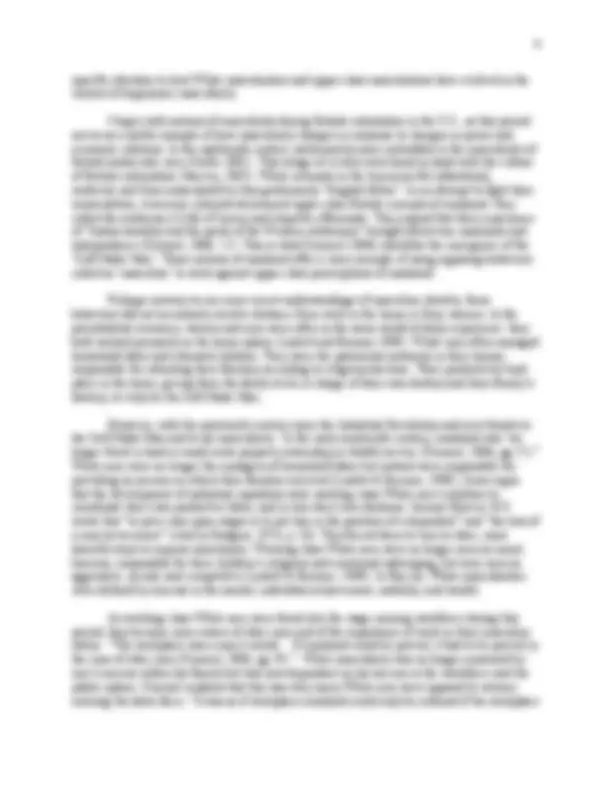
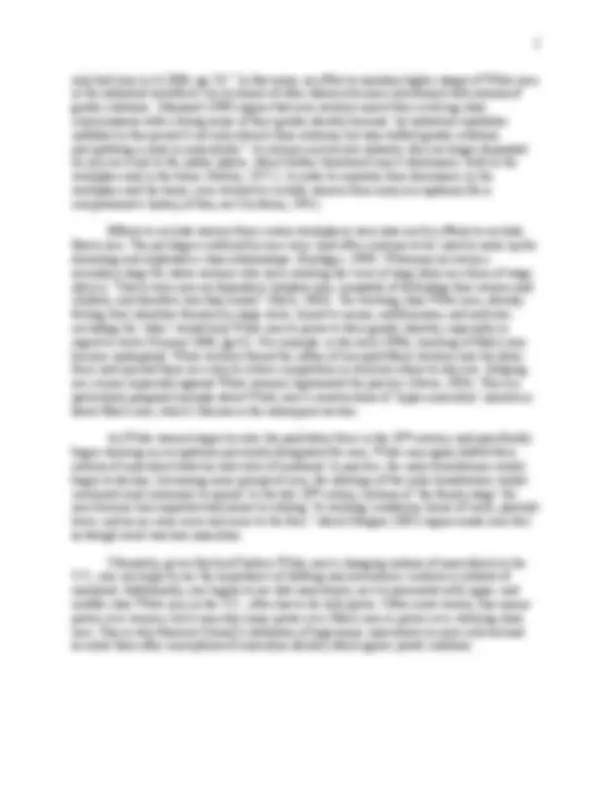
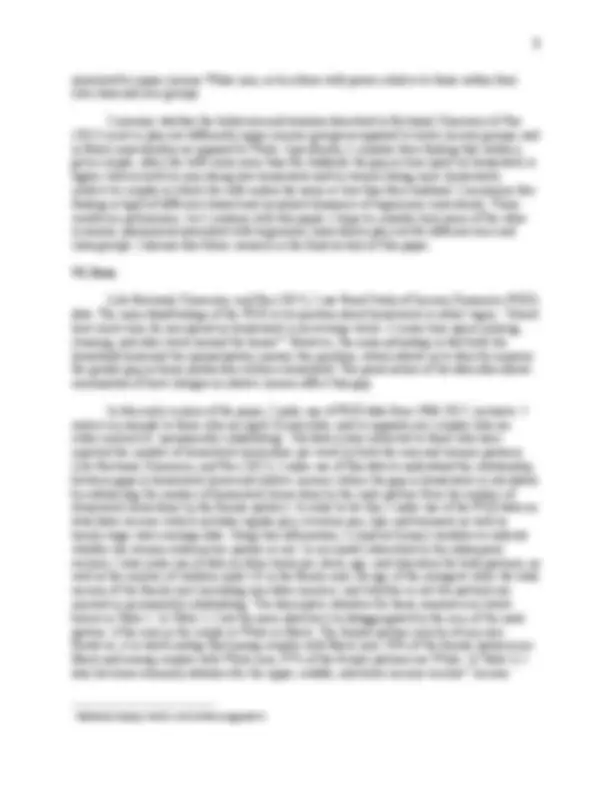
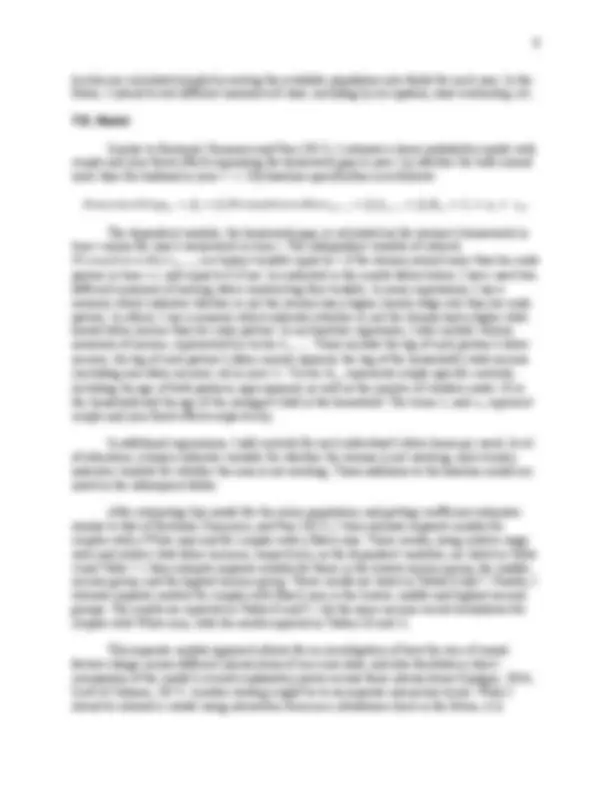
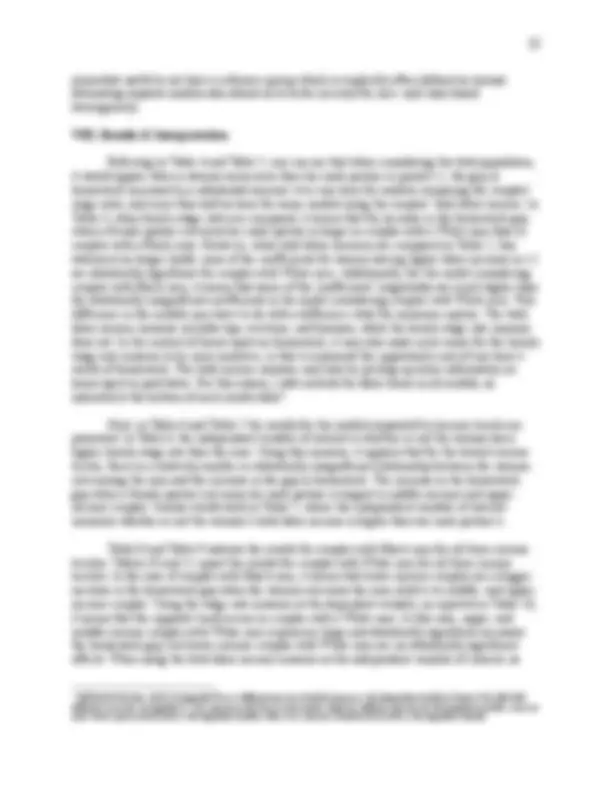
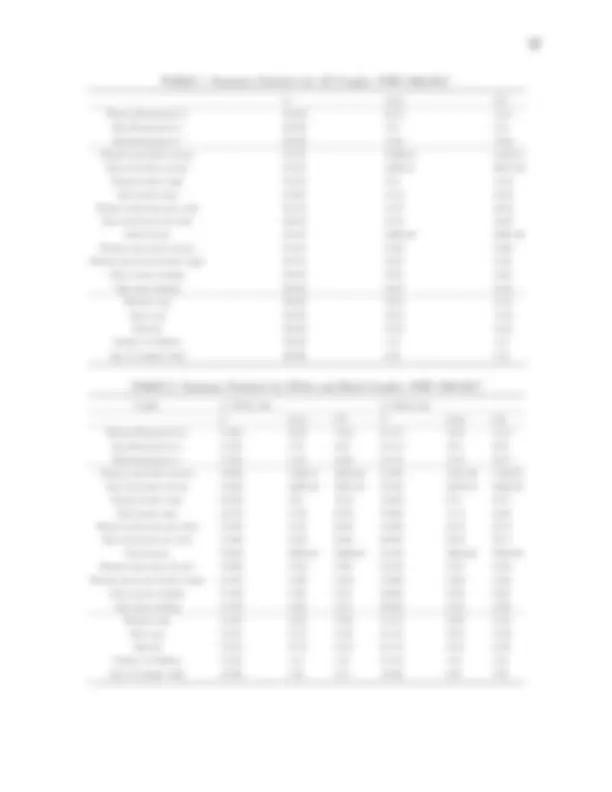
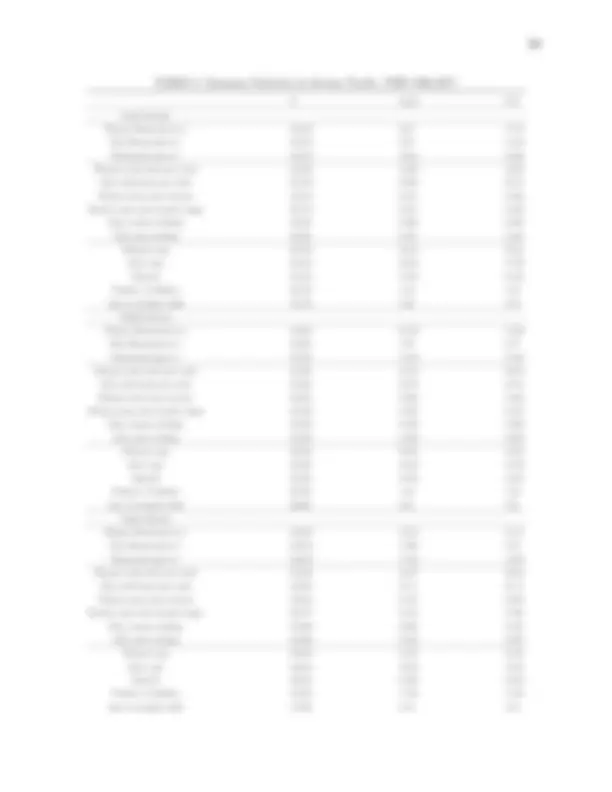



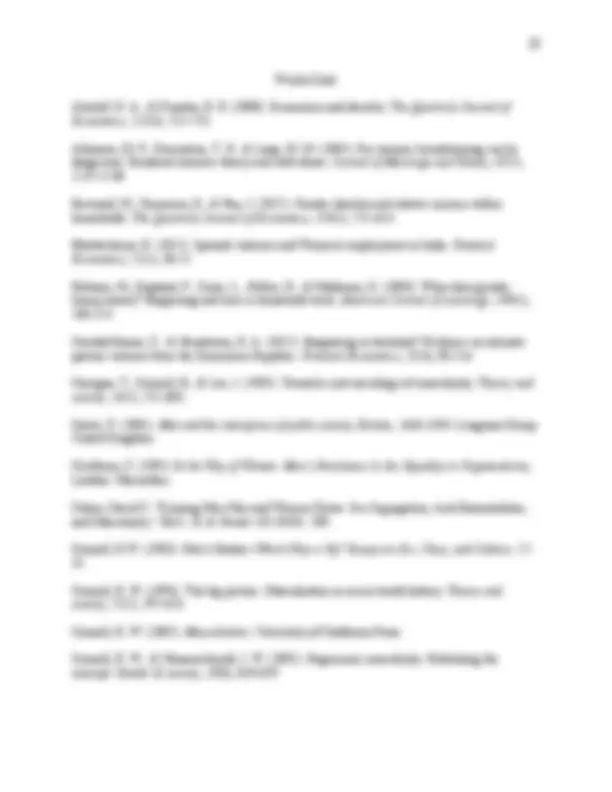

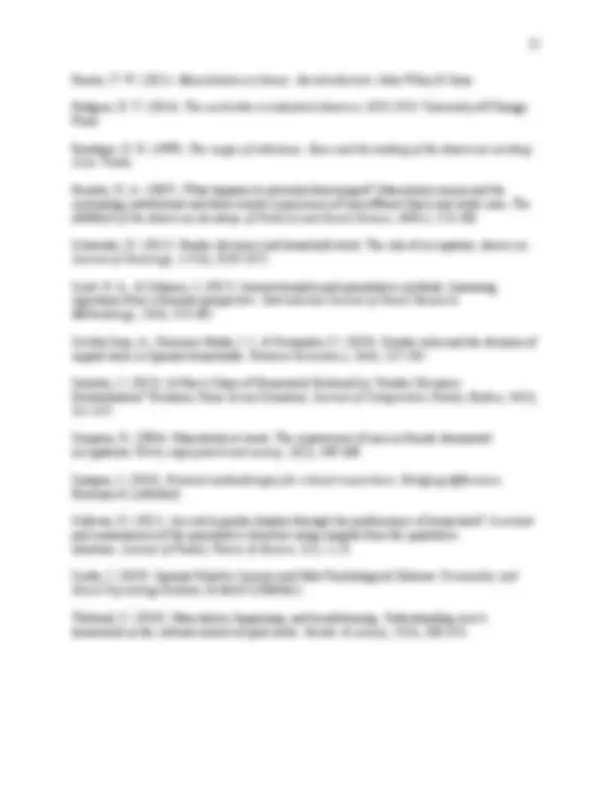
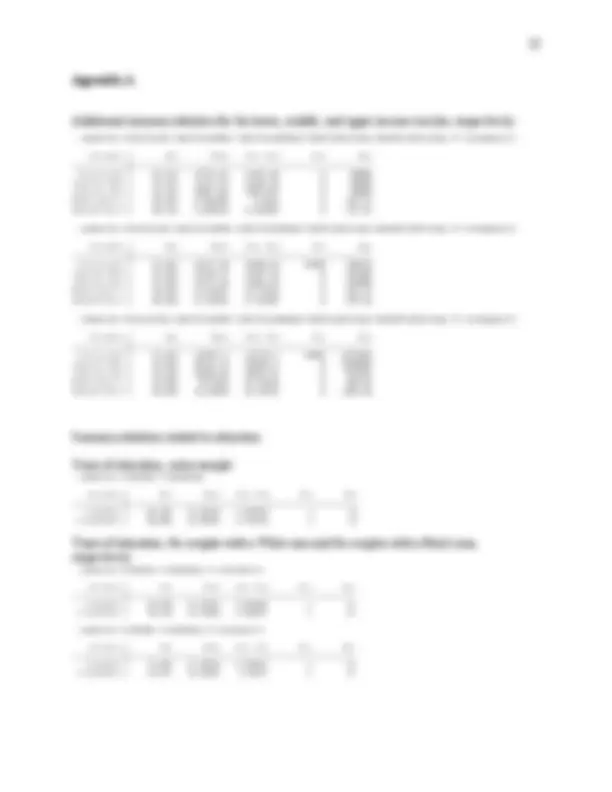


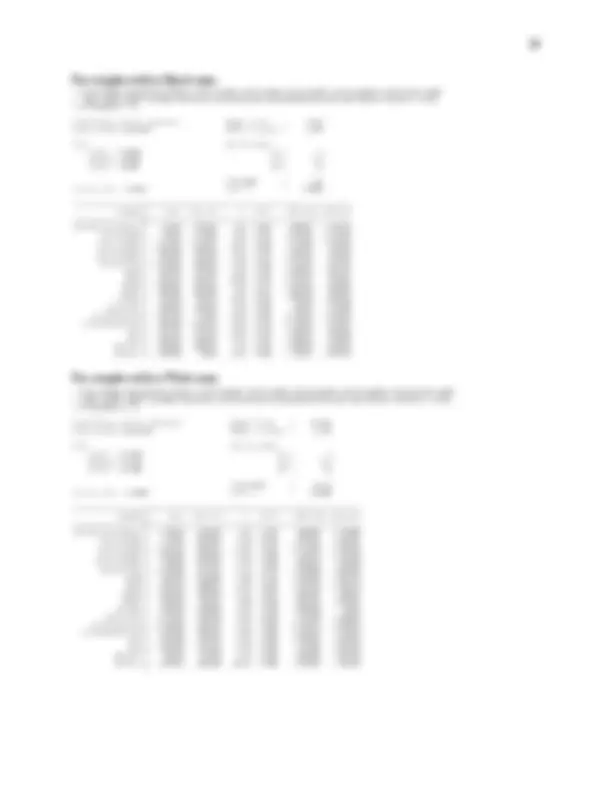
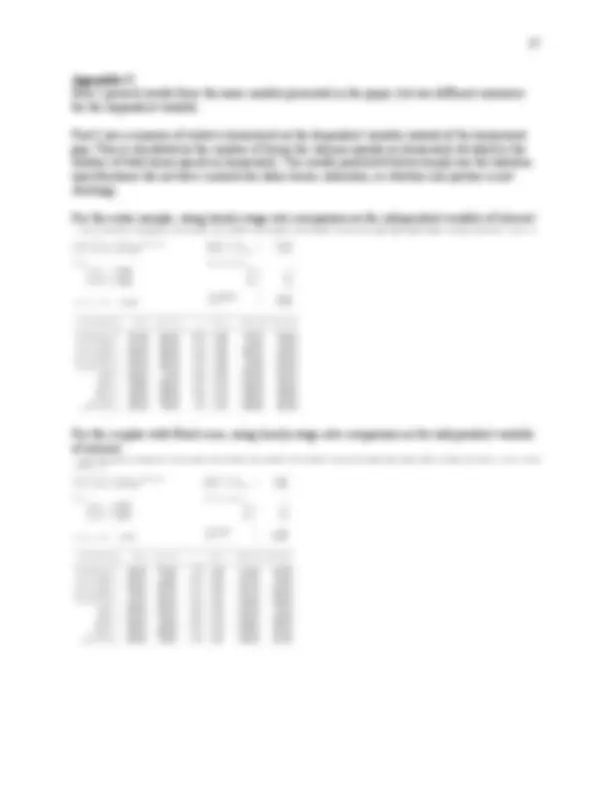


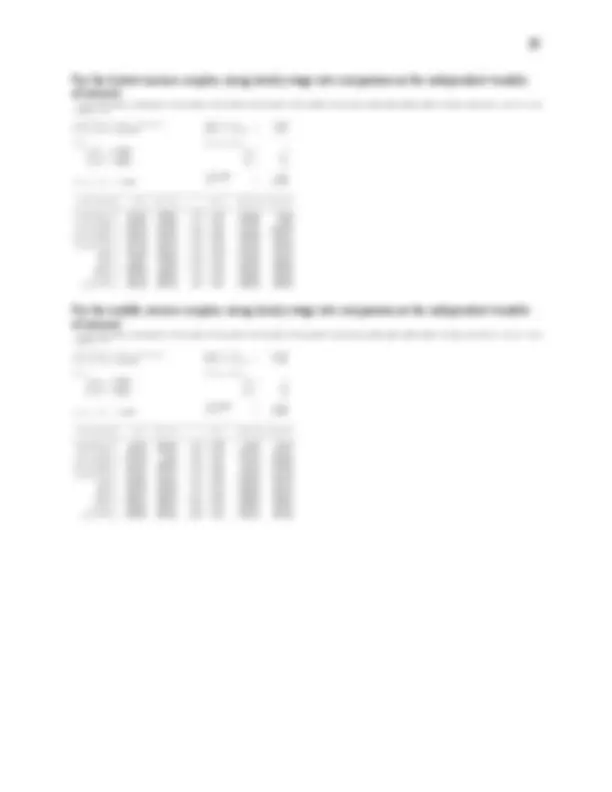
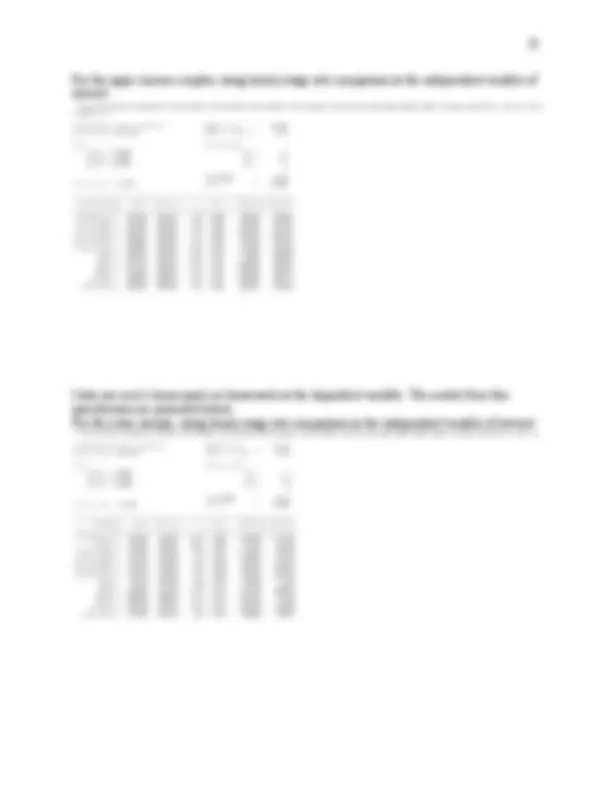
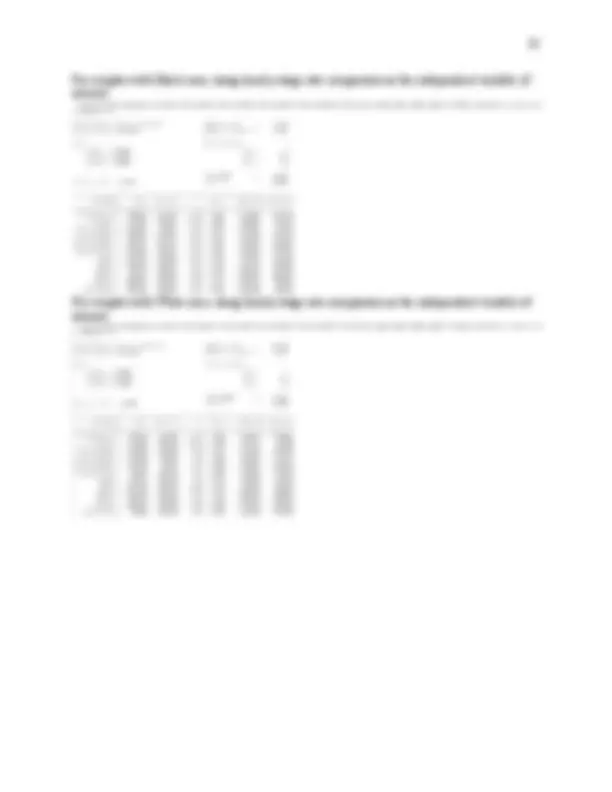
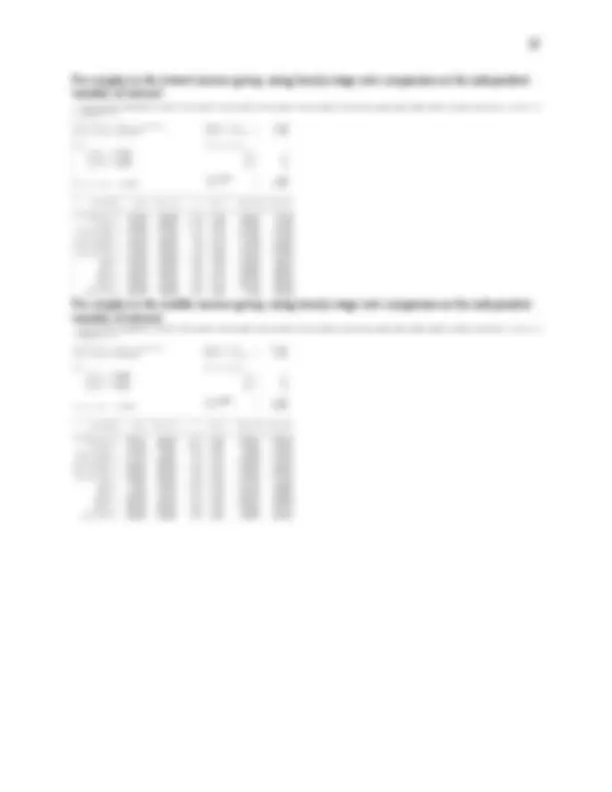

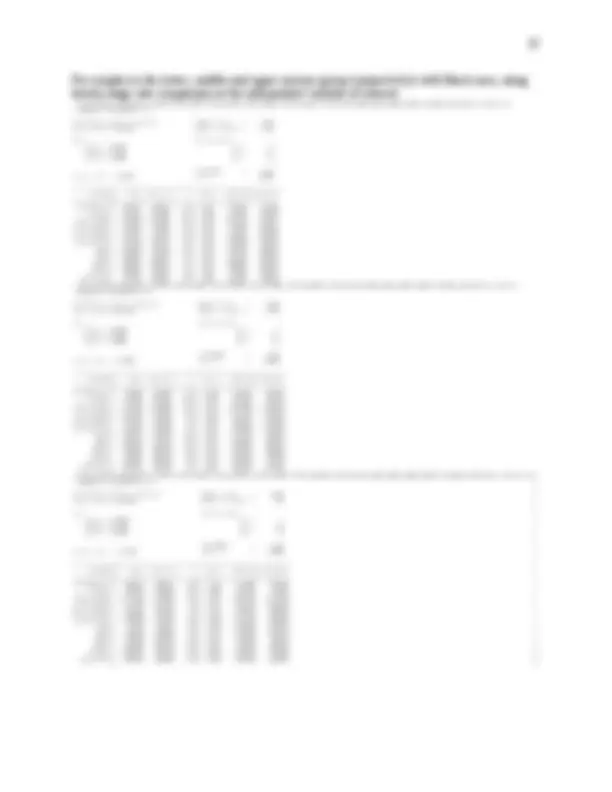
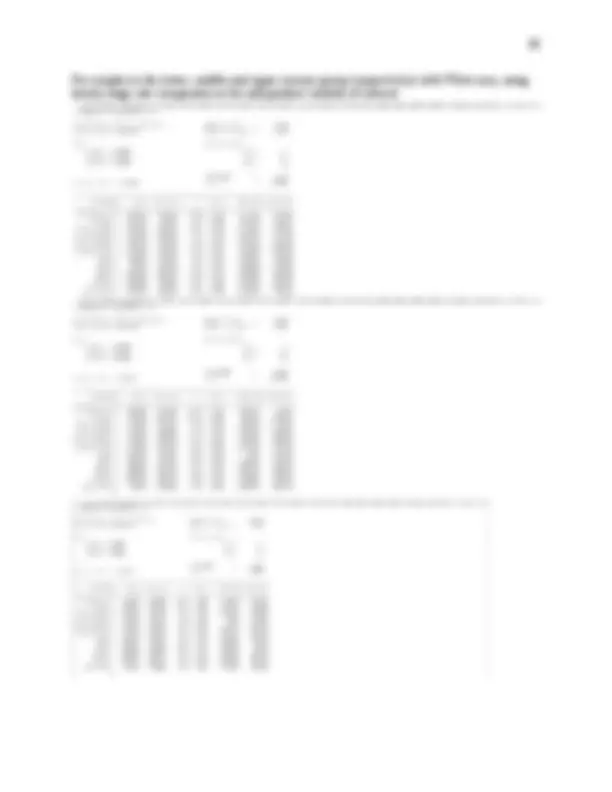


Study with the several resources on Docsity

Earn points by helping other students or get them with a premium plan


Prepare for your exams
Study with the several resources on Docsity

Earn points to download
Earn points by helping other students or get them with a premium plan
Community
Ask the community for help and clear up your study doubts
Discover the best universities in your country according to Docsity users
Free resources
Download our free guides on studying techniques, anxiety management strategies, and thesis advice from Docsity tutors
How hegemonic masculinities held by upper-income White men differ from or influence the masculine behavior and narratives of other groups of men, specifically focusing on the economic 'threats' to masculinity when a woman out-earns her male partner. Using PSID data, the study examines the historical evolution of American masculinities and the impact on men of different race and class groups. Preliminary results suggest that upper-income White men and lower-income Black men have a relatively strong aversion to the situation where a woman out-earns her male partner.
Typology: Lecture notes
1 / 36

This page cannot be seen from the preview
Don't miss anything!





























The Political Economy of Hegemonic Masculinity: Class, Race, and Work Abstract: This paper considers how the macro cultural dynamics of hegemonic masculinity complicate microeconomic negotiations within households. I begin by drawing connections among established microeconomic phenomena that scholars have attributed to a defense of masculinity or ‘gender deviance neutralization’. I then consider how hegemonic masculinities held by upper-income White men differ from or have influenced the masculine behavior and narratives of other groups of men. Specifically, I make use of PSID data to understand how men of different race and income groups respond to earning less than their female partners: an economic ‘threats’ to masculinity. Preliminary results indicate that upper-income White men have a stronger aversion to the situation in which a woman out-earns her male partner relative to lower-income White men and upper- and middle-income Black men. Using these findings, I discuss how this helps us understand the ‘hegemonic’ nature of hegemonic masculinity. I. Introduction Very few economists have directly considered the importance of masculinity in tying together many of these works. The opportunity to do so is ripe as several important connections exist. For instance, several economists have written on the “male backlash” theory in studies of intimate partner violence (Caridad Bueno & Henderson, 2017; Bhattacharya, 2015; Finnoff, 2012 ; Atkinson, Greenstein, & Lang, 2005). The male backlash theory postulates that when women begin to out-earn or otherwise out-perform their male partners, those male partners often respond with violence to reassert their dominant status in the home. In these scenarios, one could postulate that men are responding to threats to their masculine identity through violence. Other studies on intrahousehold dynamics have found that there is a general aversion to the situation in which a wife out-earns her husband, as illustrated in marriage markets, divorce and marital happiness, and allocations of housework (Bertand, Kamenica, & Pan, 2015). Again, in this case we see men’s role as breadwinner being threatened, which impacts their self-identity. Others have similarly found that men who do “women’s work” in the labor market spend more time on male-typed housework relative to men in gender-balanced occupations (Schneider, 2012). In this study, the importance of performing manhood becomes even more clear. Based on this literature, it seems that the role of gender identity, namely masculinity, is often influenced by dynamics involving work and income. Each seems to highlight the importance of working in ‘manly’ activities or breadwinning as pivotal in men’s self-image, and then in turn, in their behavior and work allocation in the home. Studies focusing on relationships outside the home follow similar trends. Perhaps most famously, Akerlof and Kranton (2000) use their model to demonstrate how a man responds to a threat to his masculine identity upon the inclusion of a woman in his workplace domain. This model only assumes a man will feel threated by the inclusion of women in his workplace, but many studies have backed this assumption. For instance, McLaughlin, Uggen, and Blackstone (2012) find women supervisors are more likely to experience sexual harassment and theorize that men see sexual harassment as an equalizer against women in power. Even men in women- dominated occupations often overcompensate for some kind of loss in masculine identity they incur by working in such fields. Cross and Baglihole (2002) and Simpson (2004) use in-depth interviews to document the experiences of men in women-dominated occupations. They find that
men often distance themselves from women colleagues or from the feminine aspects of their jobs: librarians who are men called themselves ‘information scientists,’ men working as flight attendants emphasized safety over service. Considering these studies on the whole, it starts to become clear that masculine identities are deeply embedded in notions of work and that many of the previously listed economic phenomena might be attributed to men’s efforts to preserve masculinity. As Folbre (1994) writes, “Bargaining takes place on the cultural as well as on the micro economic level…macro economic or macro cultural dynamics complicate microeconomic negotiations.” This paper considers how the macro cultural dynamics of hegemonic masculinity influence microeconomic negotiations within households. I expand on the macro cultural dynamics of masculinity by providing a brief overview of how it has been economically and historically constructed in the United States. I specifically consider how White masculinities were formed differently than and influenced notions of Black masculinities, and how upper-class masculinities were formed differently than and influenced notions of working-class masculinities^1. After examining this historical evolution, I examine whether the behaviors and tensions described in Bertrand, Kamenica & Pan (2015) exist or play out differently upper-income groups as opposed to lower income groups, and in Black masculinities as opposed to White. Specifically, I consider their finding that within a given couple, when the wife earns more than the husband, the gap in time spent on housework is higher relative to couples in which the wife makes the same or less than their husband. I reexamine this finding in light of different classed and racialized dynamics of hegemonic masculinity. Preliminary results indicate that upper- income White men might have a stronger aversion to the situation in which a woman out-earns her male partner relative to lower-income White men and upper- and middle-income Black men. Lower-income Black men also seem to have a relatively strong aversion to the situation in which a woman out-earns her male partner, especially when compared to middle- and upper-income couples with Black men. This paper’s contribution is to establish that men of different race and class groups are differently impacted by hegemonic masculinity, and thus respond differently to economic ‘threats’ to their masculinity. In future work, I hope to examine other economic ‘threats’ to masculinity along similar class and race dimensions, a question to which I return in the final section of this paper. Overall, this is an effort to understand how hegemonic masculinity operates along class and race dimensions, especially in response to shifting notions of work and income within families. II. What is Hegemonic Masculinity? Masculinity, in many ways, is a difficult concept to define: it means different things to different people based on class, race, geography, etc. Some scholars describe it relationally: masculinity as behavior that is simply “not feminine” (Cohen, 2010; ). This definition, of course, (^1) While focusing on White and upper-class masculinities may seem to place too much emphasis on those already often centered in discussion, this is an act of ‘studying up’. Studying up refers to studying the institutions and power structures that oppress people rather than ‘studying down’ and placing blame or passivity on the subaltern. Sprague (2016, p. 15) puts it best, writing that “without a parallel concentration of research focusing on the problematic character of elites and the social institutions bolstering their privilege, the focus on what is wrong with disadvantaged people creates a picture in which those on the downside of hierarchies have, and thus by implication are, problems.” Studying up, in this context, means focusing on the hegemonic group when discussing the influence of hegemonic masculinity.
specific attention to how White masculinities and upper-class masculinities have evolved in the context of hegemonic masculinity. I begin with notions of masculinity during British colonialism in the U.S., as this period serves as a useful example of how masculinity changes in response to changes in power and economic relations. In the eighteenth century, politeness became embedded in the masculinity of British aristocratic men (Carter 2001). This image of civility went hand-in-hand with the culture of British colonialism (Harvey, 2005). White colonists in the Americas felt infantilized, enslaved, and thus emasculated by this gentlemanly “English father”. In an attempt to fight their emasculation, American colonists denounced upper-class British concepts of manhood: they called the aristocracy’s life of luxury and etiquette effeminate. They argued that their experience of “Indian hostility and the perils of the Western wilderness” brought about true manliness and independence (Kimmel, 2006: 15). This is what Kimmel (2006) identifies the emergence of the ‘Self-Made Man’. These notions of manhood offer a clear example of using opposing behaviors coded as ‘masculine’ to work against upper-class prescriptions of manhood. Perhaps contrary to our more recent understandings of masculine identity, these behaviors did not necessarily involve distance from work in the home or from women. In the preindustrial economy, women and men were often in the same world of daily experience: they both worked primarily in the home sphere (Laslett and Brenner 1989). White men often managed household labor and educated children. They were the patriarchal authority in their homes, responsible for educating their families according to religious doctrine. Their productivity took place in the home, giving them the ability to be in charge of their own destiny and their family’s destiny; to truly be the Self-Made Man. However, with the nineteenth century came the Industrial Revolution and new threats to the Self-Made Man and to his masculinity. In the early nineteenth century, manhood was “no longer fixed in land or small-scale property ownership or dutiful service (Kimmel, 2006, pg 17).” White men were no longer the managers of household labor but instead were responsible for providing an income on which their families survived (Laslett & Brenner, 1989). Some argue that the development of industrial capitalism took working-class White men’s abilities to coordinate their own productive labor, and in turn their own destinies. Samuel Eliot in 1871 wrote that “to put a man upon wages is to put him in the position of a dependent” and “the less of a man he becomes” (cited in Rodgers, 1974, p. 33). This forced them to turn to other, more harmful ways to express masculinity. Working-class White men were no longer seen as moral beacons, responsible for their children’s religious and emotional upbringing, but were seen as aggressive, sexual, and competitive (Laslett & Brenner, 1989). In this era, White masculinities were defined by success in the market, individual achievement, mobility, and wealth. As working-class White men were thrust into the wage-earning workforce during this period, they became more aware of other men and of the importance of work in their masculine status. “The workplace was a man’s world… If manhood could be proved, it had to be proved in the eyes of other men (Kimmel, 2006, pg 19).” White masculinity was no longer measured by one’s success within his family but was now dependent on his success in the workforce and the public sphere. Kimmel explains that this was why many White men were opposed to women entering the labor force: “it was as if workplace manhood could only be retained if the workplace
only had men in it (2006, pg 23).” In this sense, an effort to maintain higher wages of White men in the industrial workforce via exclusion of other laborers became intertwined with notions of gender relations. Maynard (1989) argues that men workers mixed their evolving class consciousness with a strong sense of their gender identity because “as industrial capitalism unfolded in this period it not only altered class relations, but also shifted gender relations precipitating a crisis in masculinity.” As women moved into industry, they no longer depended on men as a link to the public sphere, which further threatened men’s dominance, both in the workplace and in the home (Hacker, 1957;). In order to maintain their dominance in the workplace and the home, men worked to exclude women from many occupations (for a comprehensive history of this, see Cockburn, 1991). Efforts to exclude women from certain workplaces were also met by efforts to exclude Black men. The privileges conferred by race were (and often continue to be) used to make up for alienating and exploitative class relationships. (Roediger, 1999). Whiteness served as a secondary wage for white workers who were resisting the view of wage labor as a form of wage slavery. “Slaves were seen as dependent, helpless men, incapable of defending their women and children, and therefore less than manly” (Hoch, 2004). For working class White men, already feeling their identities threated by wage work, turned to racism, antifeminism, and nativism: excluding the ‘other’ would help White men to preserve their gender identity, especially in regard to work (Kimmel 2006, pg 62). For example, in the early 1900s, lynching of Black men became widespread. White workers feared the influx of low paid Black workers into the labor force and lynched them as a way to reduce competition or terrorize others to stay out. Alleging sex crimes (especially against White women) legitimated the practice (Davis, 198 3 ). This is a particularly poignant example about White men’s constructions of ‘hyper-masculine’ narratives about Black men, which I discuss in the subsequent section. As White women began to enter the paid labor force in the 20th^ century, and specifically began working on occupations previously designated for men, White men again shifted their notions of masculine behavior and roles of manhood. In practice, the male-breadwinner model began to decline, but among some groups of men, the ideology of the male-breadwinner model continued (and continues) to persist. In the late 20th^ century, notions of ‘the family wage’ for men became less important and issues to relating “to working conditions, hours of work, parental leave, and so on came more and more to the fore,” which Morgan (2005) argues made men feel as though work was less masculine. Ultimately, given this brief history White men’s changing notions of masculinity in the U.S., one can begin to see the importance of shifting macroeconomic contexts in notions of manhood. Additionally, one begins to see that masculinity, as it is associated with upper- and middle-class White men in the U.S., often has to do with power. Often most clearly, this means power over women, but it may also mean power over Black men or power over working-class men. This is why Raewyn Connell’s definition of hegemonic masculinity is more relevant and accurate than other conceptions of masculine identity which ignore power relations.
When a powerful group in society codes Black men as ‘excessive’ and ‘out of control’, this provides justifications for heavy surveillance, incarceration, and other punishments of Black men, even when Black men enact gender norms in similar ways to White men. Scholars have found that in educational, labor market, and criminal justice settings, “black men pay a disproportionate price for enacting masculinity norms in comparison to white males” with similar incomes (Royster, 2007). Additionally, placing White (in this case, the hegemonic) masculinity in the middle group serves to maintain the dominance of the hegemonic group, both by heavy surveillance and punishment of black man, and by coding them as lacking intelligence, culture, or self-control. Similar dynamics exist when one considers the role of class and hegemonic masculinity in forming working-class conceptualizations of manhood. Morgan (2005) also discusses the shift of more and more men into service work in the late 20th^ century. He writes that upper- and middle-income working men aimed make this work seem masculine and to separate themselves from work done by the masses. Because of this, working-class men “were presented as sheep who were easily led by politically motivated leaders or group pressure. Management, on the other hand, was presented as dealing with some of the key issues in the national economy” (pp. 170). In response, working class men constructed their masculinity as collective, physical, and oppositional: similar in many ways to the White colonists in America opposing British aristocracy. Additionally, designations of ‘skilled’ and ‘unskilled’ work were changing, largely driven by the capitalist class and an economic shift to service sector work. Men in the ‘unskilled’ category responded by prescribing physical strength to their masculine identities if they were to be excluded from notions of technical mastery (Maynard, 1986). On the other hand, middle and upper-class men working in services associated their masculinity with individuality, rationality, and intelligence. Again, efforts put forth by the hegemonic group to redefine masculine work or behavior places them in the optimal position: upper- and middle-income men seen as rational leaders and individuals rather than brutish sheep. In this way, the hegemonic group is again considered to have the perfect ‘amount’ of manhood relative to the oppressed working class. V. Empirical Research Questions Given this background, my research question is largely about how hegemonic masculinity influences the behavior of men inside and outside the hegemonic group. How does the notion of ‘all men must contend’ in Connell’s definition of hegemonic masculinity play out? In a U.S. context, I ask who is the dominant group maintaining hegemonic masculinity and what are their masculine behaviors. What are the masculine behaviors that upper class White men set as standards for masculinity in which ‘all men must contend’? I also ask how other groups of men adopt or do not adopt similar behaviors. Who reinforces behaviors associated with hegemonic masculinity and who works against them? Carrigan, Connell, and Lee (1985) and Connell and Messerschmidt (2005) have discussed the possibility that there are hegemonic masculinities, plural: a hierarchy of sorts, subject to local, national and global dynamics, and to class and race dynamics. In other words, there are certainly overlapping modes of oppression which suggests that men in different class and race groups would behave differently when contending with hegemonic masculinity, as
presented by upper-income White men, or by others with power relative to those within their own class and race groups. I examine whether the behaviors and tensions described in Bertrand, Kamenica & Pan (2015) exist or play out differently upper-income groups as opposed to lower income groups, and in Black masculinities as opposed to White. Specifically, I consider their finding that within a given couple, when the wife earns more than the husband, the gap in time spent on housework is higher (driven both by men doing less housework and by women doing more housework) relative to couples in which the wife makes the same or less than their husband. I reexamine this finding in light of different classed and racialized dynamics of hegemonic masculinity. These results are preliminary. As I continue with this paper, I hope to consider how some of the other economic phenomena associated with hegemonic masculinity play out for different race and class groups. I discuss this future research in the final section of this paper. VI. Data Like Bertrand, Kamenica, and Pan (2015), I use Panel Study of Income Dynamics (PSID) data. The main disadvantage of the PSID is its question about housework is rather vague: “About how much time do you spend on housework in an average week—I mean time spent cooking, cleaning, and other work around the house?” However, the main advantage is that both the household head and the spouse/partner answer the question, which allows us to directly measure the gender gap in home production within a household. The panel nature of the data also allows examination of how changes in relative income affect this gap In this early version of the paper, I make use of PSID data from 1986- 201 7, inclusive. I restrict my sample to those who are aged 18 and older, and to opposite-sex couples who are either married or ‘permanently cohabitating’. My data is also restricted to those who have reported the number of housework hours done per week by both the man and woman partners. Like Bertrand, Kamenica, and Pan (2015), I make use of this data to understand the relationship between gaps in housework hours and relative income (where the gap in housework is calculated by subtracting the number of housework hours done by the male partner from the number of housework hours done by the female partner). In order to do this, I make use of the PSID data on total labor income (which includes regular pay, overtime pay, tips, and bonuses) as well as hourly wage rates earnings data. Using this information, I construct binary variables to indicate whether the woman outearns her partner or not. In my model (described in the subsequent section), I also make use of data on labor hours per week, age, and education for both partners, as well as the number of children under 18 in the family unit, the age of the youngest child, the total income of the family unit (including non-labor income), and whether or not the partners are married or permanently cohabitating. The descriptive statistics for these measures are listed below in Table 1. In Table 2, I list the same data but it is disaggregated by the race of the male partner: if the man in the couple is White or Black. The female partner may be of any race. However, it is worth noting that among couples with Black men, 93% of the female partners are Black and among couples with White men, 97% of the female partners are White. In Table 3, I also list some summary statistics for the upper, middle, and lower income terciles^2. Income (^2) Additional summary statistics can be found in Appendix A.
somewhat useful to not have a reference group which is implicitly often defined as normal. Estimating separate models also allows us to better account for race- and class-based heterogeneity. VIII. Results & Interpretation Referring to Table 4 and Table 5, one can see that when considering the total population, it would appear when a woman earns more than her male partner in period t - 1, the gap in housework increases by a substantial amount: over one hour for models comparing the couples’ wage rates, and more than half an hour for some models using the couples’ total labor income. In Table 4, when hourly wage rates are compared, it seems that the increase in the housework gap when a female partner out earns her male partner is larger in couples with a White man than in couples with a Black man. However, when total labor incomes are compared in Table 5, this statement no longer holds: none of the coefficients for women having higher labor incomes in t - 1 are statistically significant for couples with White men. Additionally, for the model considering couples with Black men, it seems that some of the coefficients’ magnitudes are much higher than the statistically insignificant coefficients in the model considering couples with White men. This difference in the models may have to do with a difference what the measures capture. The total labor income measure includes tips, overtime, and bonuses, while the hourly wage rate measure does not. In the context of hours spent on housework, it may also make more sense for the hourly wage rate measure to be more sensitive, in that it represents the opportunity cost of one hour’s worth of housework. The total income measure may also be picking up some information on hours spent in paid labor. For this reason, I add controls for labor hours in all models, as indicated at the bottom of each results table^3. Next, in Table 6 and Table 7 the results for the models separated by income tercile are presented. In Table 6, the independent variable of interest is whether or not the woman has a higher hourly wage rate than the man. Using this measure, it appears that for the lowest income tercile, there is a relatively smaller or statistically insignificant relationship between the woman out-earning the man and the increase in the gap in housework. The increase in the housework gap when a female partner out earns her male partner is largest in middle-income and upper- income couples. Similar results hold in Table 7, where the independent variable of interest measures whether or not the woman’s total labor income is higher than her male partner’s. Table 8 and Table 9 indicate the results for couples with Black men for all three income terciles. Tables 10 and 11 report the results for couples with White men for all three income terciles. In the case of couples with Black men, it seems that lower-income couples see a bigger increase in the housework gap when the woman out-earns the man relative to middle- and upper- income couples. Using the wage-rate measure as the dependent variable, as reported in Table 10, it seems that the opposite trend occurs in couples with a White man. In this case, upper- and middle-income couples with White men experience large and statistically significant increases the housework gap, but lower-income couples with White men see no statistically significant effects. When using the total labor income measure as the independent variable of interest, as (^3) Additional robustness checks in Appendix B use a different measure of relative income as the independent variable of interest but offer little difference in results. In Appendix C, I also present results from several models which use different measures for the dependent variable: some use men’s hours spent on housework as the dependent variable, others use a measure of relative housework as the dependent variable.
reported in Table 11, there are no statistically significant results for any income tercile with White men in the partnership. Overall, based on the results presented in Table 8 and Table 10, it seems that upper- and middle-income White men might have a stronger aversion to the situation in which a woman out- earns her male partner relative to lower-income White men and upper- and middle-income Black men. Lower-income Black men in this model also seem to have a relatively strong aversion to the situation in which a woman out-earns her male partner, especially when compared to middle- and upper-income couples with Black men (as indicated in the results presented in Table 8 and Table 9). However, these preliminary results should be interpreted cautiously, as there are some overlapping confidence intervals among these groups, and the results are somewhat sensitive to which type of income measure is used. What do these results mean in light of research done on hegemonic masculinity? Recall that the broader research questions are as follows: What are the masculine behaviors that upper class White men set as standards for masculinity in which ‘all men must contend’? Who reinforces behaviors associated with hegemonic masculinity and who works against them? Given the previous discussion about the dynamics of hegemonic masculinity, it seems that middle-income White men and lower-income Black men contend with the masculinity norms set by upper-income White men by conforming to and simulating them in some way. Upper- and middle-income Black men may be opposing these norms as a way to retaliate against notions of White manhood or to establish their own notions of Black manhood. More specifically, this may be an example of Black men combatting the White narratives of Black ‘man in overdrive’, as Reeser (2011) puts it. Lower-income Black men, oppressed by both racism and class dynamics, may be emulating behaviors found in the hegemonic group as a way of reasserting manhood and dominance. Lower-income White men, who may be oppressed by class dynamics, but still receive the ‘wages of Whiteness’ may be attempting to position themselves in the middle ground, as Reeser (2011) argues, relative to Black men in their same income group. However, more empirical work studying responses other ‘threats’ to masculinity is necessary in order to understand whether these trends generally hold. IX. Conclusions & Future Work Ultimately, this analysis only offers a peek into the dynamics of hegemonic masculinity. In order to get a more robust understand of how various groups of men contend with prescriptions of masculinity passed down the by hegemonic groups in society, one must consider other expressions of manhood and how different groups respond to ‘threats’ to masculinity. I intend to do this in future work. For instance, I will consider other dynamics which might influence relative housework: I could consider how occupational segregation impacts notions of ‘manhood’ and thus performances of housework (similar to Schneider, 2012), or perhaps the impact of unemployment or public assistance as ‘threats’ to masculinity. In these analyses, similar to the one I have taken on here, I will break down analyses based on race and class groups. I will also consider other dependent variables in my models aside from housework. For instance, Syrda (2019) finds that men have increasing levels of stress when their wives begin to out-earn them. Does this vary by race and class groups? One might also consider a class and race
Works Cited Akerlof, G. A., & Kranton, R. E. (2000). Economics and identity. The Quarterly Journal of Economics , 115 (3), 715-753. Atkinson, M. P., Greenstein, T. N., & Lang, M. M. (2005). For women, breadwinning can be dangerous: Gendered resource theory and wife abuse. Journal of Marriage and Family , 67 (5), 1137 - 1148. Bertrand, M., Kamenica, E., & Pan, J. (2015). Gender identity and relative income within households. The Quarterly Journal of Economics , 130 (2), 571-614. Bhattacharya, H. (2015). Spousal violence and Women's employment in India. Feminist Economics , 21 (2), 30- 52 Bittman, M., England, P., Sayer, L., Folbre, N., & Matheson, G. (2003). When does gender trump money? Bargaining and time in household work. American Journal of sociology , 109 (1), 186 - 214 Caridad Bueno, C., & Henderson, E. A. (2017). Bargaining or backlash? Evidence on intimate partner violence from the Dominican Republic. Feminist Economics , 23 (4), 90-116. Carrigan, T., Connell, B., & Lee, J. (1985). Toward a new sociology of masculinity. Theory and society , 14 (5), 551-604. Carter, P. (2001). Men and the emergence of polite society, Britain, 1660- 1800. Longman Group United Kingdom. Cockburn, C. (1991) In the Way of Women: Men’s Resistance to Sex Equality in Organisations , London: Macmillan. Cohen, David S. "Keeping Men Men and Women Down: Sex Segregation, Anti-Essesntialism, and Masculinity." Harv. JL & Gender 33 (2010): 509. Connell, R.W. (1983). Men’s Bodies. Which Way is Up? Essays on Sex, Class, and Culture, 17 -
Connell, R. W. (1993). The big picture: Masculinities in recent world history. Theory and society , 22 (5), 597-623. Connell, R. W. (2005). Masculinities. University of California Press. Connell, R. W., & Messerschmidt, J. W. (2005). Hegemonic masculinity: Rethinking the concept. Gender & society , 19 (6), 829-859.